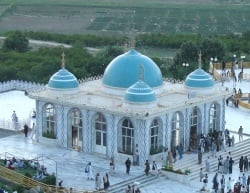Kandahar: Difference between revisions
Hari singh (talk | contribs) No edit summary |
Hari singh (talk | contribs) No edit summary |
||
| Line 2: | Line 2: | ||
'''Kandahĝr''' {{coord|31.605|N|65.76|E}}, also spelled Qandahĝr, is the second largest city in [[Afghanistan]] after Kabul, the capital and has a population of 324,800 (2006 estimate). It is the capital of Kandahar province, located in the south of the country at about 1,005 m (3,297 feet) above sea level. The Arghandab River runs right next to the city. | '''Kandahĝr''' {{coord|31.605|N|65.76|E}}, also spelled Qandahĝr, is the second largest city in [[Afghanistan]] after Kabul, the capital and has a population of 324,800 (2006 estimate). It is the capital of Kandahar province, located in the south of the country at about 1,005 m (3,297 feet) above sea level. The Arghandab River runs right next to the city. | ||
Hamid Karzai, the 12th President of Afghanistan is an ethnic Pashtun of the Popalzai tribe. He was born in the village of Karz, which is located on the edge of Kandahar in southern Afghanistan. | Hamid Karzai, the 12th President of Afghanistan is an ethnic Pashtun of the Popalzai tribe. He was born in the village of Karz, which is located on the edge of Kandahar in southern Afghanistan. | ||
| Line 12: | Line 10: | ||
The shrine of [[Baba Wali]], its terraces shaded by pomegranate groves beside the Arghandab River, is also very popular for picnics and afternoon outings. | The shrine of [[Baba Wali]], its terraces shaded by pomegranate groves beside the Arghandab River, is also very popular for picnics and afternoon outings. | ||
Sitting on the banks of the Arghandab River is the Baba Wali Shrine, also known as Baba Sahib by Kandaharis. Gul Agha Sherzai, the twice-former Governor of Kandahar, fierce warlord and former Mujahideen commander constructed the shrine at a cost of millions of dollars to honour one of his revered tribesmen. | Sitting on the banks of the Arghandab River is the Baba Wali Shrine, also known as Baba Sahib by Kandaharis. Gul Agha Sherzai, the twice-former Governor of Kandahar, fierce warlord and former Mujahideen commander constructed the shrine at a cost of millions of dollars to honour one of his revered tribesmen. | ||
It provides a great view to the verdant Arghandab Valley, which is in stark contrast to the rest of the dusty province. The multi-level shrine, marble and mirror-clad, set into a hillside is a popular picnic place for the Kandaharis, with kebabs, hand made ice cream and local fruit juices available from cart vendors. | |||
==Ancient history== | ==Ancient history== | ||
Revision as of 20:20, 4 September 2009

photo by Ghousuddin Frotan
Kandahĝr , also spelled Qandahĝr, is the second largest city in Afghanistan after Kabul, the capital and has a population of 324,800 (2006 estimate). It is the capital of Kandahar province, located in the south of the country at about 1,005 m (3,297 feet) above sea level. The Arghandab River runs right next to the city.
Hamid Karzai, the 12th President of Afghanistan is an ethnic Pashtun of the Popalzai tribe. He was born in the village of Karz, which is located on the edge of Kandahar in southern Afghanistan.
Baba Wali's shrine
The shrine of Baba Wali, its terraces shaded by pomegranate groves beside the Arghandab River, is also very popular for picnics and afternoon outings.
Sitting on the banks of the Arghandab River is the Baba Wali Shrine, also known as Baba Sahib by Kandaharis. Gul Agha Sherzai, the twice-former Governor of Kandahar, fierce warlord and former Mujahideen commander constructed the shrine at a cost of millions of dollars to honour one of his revered tribesmen.
It provides a great view to the verdant Arghandab Valley, which is in stark contrast to the rest of the dusty province. The multi-level shrine, marble and mirror-clad, set into a hillside is a popular picnic place for the Kandaharis, with kebabs, hand made ice cream and local fruit juices available from cart vendors.
Ancient history
Many empires have long fought over the city, due to its strategic location along the trade routes of Southern and Central Asia. In 1748, Ahmad Shah Durrani, founder of the Durrani Empire, made Kandahar the capital of Afghanistan.
It is believed that Kandahar may have derived from the Pashto pronunciation of Alexandria, or Iskanderiya.[3] A temple to the deified Alexander as well as an inscription in Greek and Aramaic by the Indian Emperor Ashoka, who lived a few decades later, have been discovered in the old citadel.
See also
- Wali Qandhari
- Gurdwara Panja Sahib
- Guru Nanak
- Rawalpindi
- Hasan Abdal
- Guru Nanak and Baba Wali Qandhari
- See Wikipedia article on Kandahar for more information
External links
- Youtube video of the shrine Singing in Pastu (non English videos)
